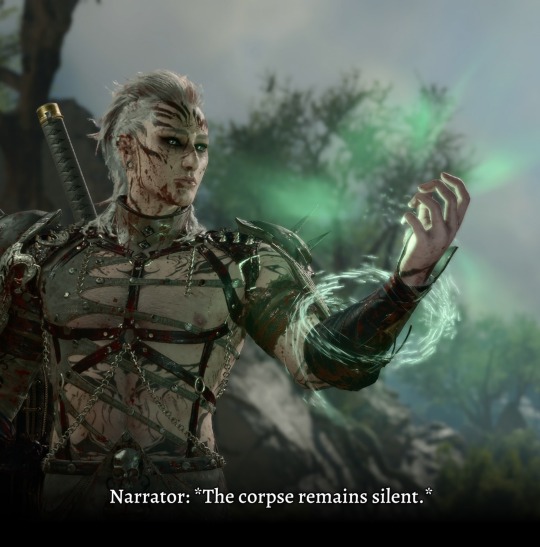#wto oc
Explore tagged Tumblr posts
Text

"•••• Housecleaning: A Pardoner can drive away Spectres by cloaking themselves in purity."
Another old wraith NPC. I think I made him up about 7 years ago, but I still love him and he seems successful to me. I've always been fascinated by Castigate and the possibilities it opens up for communication with Spectres. Here it is a very successful wraith in this Arcanos. And I just couldn't help but draw the ability that impresses me the most
#art#artists on tumblr#digital art#wod#wod art#ttrpg#ttrpg art#world of darkness#ttrpg oc#wod oc#original character#wto#wto oc#wraith the oblivion#wraith#dark art#dark aesthetic#gothic punk#gothic#goth aesthetic#punk aesthetic#Pardoner#graphic art#oc#oc art#my ocs#black and white#spectre
79 notes
·
View notes
Text

She's never afraid to get her hands dirty. Time after time, she dips her fingers into the darkest corners of the souls. Maybe that's why she likes hands so much. Especially the big, strong hands that... Ahem. On the other hand (sorry... I just... it's stronger than me...), it's part of her job to help wraiths maintain the remnants of sanity in this ruthless and insane world. But... Quis custodiet ipsos custodes? OC belongs to @malky-tea <:3
#artists on tumblr#digital art#oc#not my oc#world of darkness#wod#wod art#wod oc#digital illustration#ttrpg#ttrpg art#wto oc#wto#wraith the oblivion#castigate#pardoner#pardoners
93 notes
·
View notes
Text






Today is my birthday! Really happy to be here, to be me, to be with my friends, to be in this beautiful worldddddddddd thank you for your support and inspiration, I adore people so much My artworks wouldn't exist without such beautiful souls arounds me
#art#artists on tumblr#digital art#world of darkness#wod#oc#fae#changeling the dreaming#ctd#faerie#vtm art#vtm#vtm oc#vampire the masquerade#wraith the oblivion#wto
27 notes
·
View notes
Text

trying to figure out this butch werewolf, hunter from the tundra, interrogator & judge.
38 notes
·
View notes
Text

making a new color ref in the cutest way possible
speedrun of all my player characters:
artemiy+salem+mariah -> lasombra with fleshcrafting & DID, Joon -> Volgirre with Sire trauma, Rosario -> Ananke starting a new religion, Laine -> Mage of blood and pain, Valerie -> big game hunter, Elif -> gangrel in love with her besties, Dino -> depressed brujah photographer, Flynn -> nerdy little egg ghost, Francesca -> former detective now ghost, Heather -> most fail girl ventrue, Laszló -> genderqueer gambler nossie
#these guys are actually all on one line#cuz ill add more#also not the newest hunter included because that game fell apart before i properly cared about him at all#wod#vtm oc#wod oc#mta#mta oc#vtm#chibi#wto#world of darkness
5 notes
·
View notes
Text

A birthday present for a friend🎲🃏💚
22 notes
·
View notes
Text

I've been sooooooo artblocked lately, it's awful. So I drew my ttrpg OCs from all over the place in fancy (or not) outfits referenced from Pinterest
And then I proceeded to forget to post it. Yay.
Short overview of folk here, from left to right:
- Claude from Wraith: the Oblivion. He led quite a miserable life and ended up in the Legion of Paupers, but not before spending some time as a thrall. He had only recently caught some semblance of a break. Yeah.
- Ruben, son of Aphrodite from Scion: becoming as gods ttrpg. He is pretty grim, despite his looks and heritage, but not without a reason.
- Sharla, my Promethean: the Created girlie. Made by her creator to serve as a protector, she still fulfills her role – just in another group of people.
- Adlar, King of Summer in my Changeling: the Lost freehold. He hasn't actually been to Arcadia, but because he is a son of mortal woman and banished Gentry (so-called Charlatan) (a fact Adlar abhors and hides to the best of his ability) he is still technically a Changeling stuck in this whole changeling business
- Arcuvol, my good drow™ from DnD, because whenever I see some sort of evil faction I have to make a non-evil OC for it. (I'm never showing my Warhammer OCs to the world... Okay, they are still kinda evil when they should be). I was trying to make my own setting with DnD mechanics, but it's kinda dead now, so I don't know what to say.
#artists on tumblr#original character#ttrpg character#changeling the lost#dnd oc#scion 2e#promethean the created#wod oc#wod#spctr ptc#spctr ctl#spctr wto#spctr dnd#spctr scion#scion rpg#ttrpg oc#ttrpg art
16 notes
·
View notes
Text


that’s his work uniform
2 notes
·
View notes
Text
*swings around phone like a sloshing wine glass* Just felt like sharing some personal VTM lore!
So we were on a VTM RP discord server where the ST was one guy so we just mostly did our own scenes and character write ups so I of course monologued and made up my own scenes as my Hecata Noa all the time. I had big dots in spirit servant - and her powerful wraith was the elder brother she'd killed (to protect him it's a whole other story) who the ST mixed in rules from Wraith the Oblivion with. A lil op but I was responsible enough to be allowed to have it. 🤭 Wraith brother had dots in the arcanoi: possession. So he could take things over and eventually control people after enough points were put in. One thing that happens to wraiths with possession is that they begin becoming an amalgamation of what they possess often.
So! Noa was introduced to a nice government official through a mutual friend, whom she began dating so that she would have a safe body for her wraith servant brother to use without fear of being caught. (Obviously by being a vampire blood-bonding and using domination if needed) The official was an overweight gentleman, nothing that mattered to Noa, he was very reliable and she's not wholly a sexed up person anyway. She liked him a lot, for a human. However her brother is scum and judgemental and rude, and demanded he break up with this official because - low and behold - he was starting to lose his gym bro body due to the morphing nature of being a possessing Wraith.
So I had to lose a faithful and high ranking government servant because my spirit servant couldn't handle being chunky. RIP it sucks to suck. This is why we got stuck with useless but beautiful Julian! (This probably saved that official's life in the long term but that post break up blood bonding detox probably sucked)
(So much context is missing for many things but haha!)

The brother in question. Asshole!
11 notes
·
View notes
Text
a shapeshifter that has had such a fluid form for so long shifting from one form to the next,they lose their sense of once being human. of what it is like to have one's own body. you share it with all these shifting shapes yet you are still alone if not for your demons. an unstoppable object is your body and the psyche an immovable mass. what did I once look like. what have I forgotten. have I lost something or gained ascension. I do not know
generally not super into shapeshifter characters being revealed to have like a singular True Form. isnt it much more interesting to imagine a creature so fluid and ever-changing that even they cant identify any one body as the "true" self, or simply dont see the need to?
is this you? yes. this one too? yes. but then which one is the real you? define "real" define "you" theyre all me. even the ones that are someone else? especially those.
#oc tag: rain#wraith the oblivion#wto#when the narrative is genuinely trying to kill you and also lives inside your head and also is you#also youre dead#dont even get me started on gender#on top of all that#you Live in a Society#ghost rome#you heard me right ghost rome#edit sorry op#sorry op i went on a ramble
47K notes
·
View notes
Text

My old NPC is a wraith with a really long neck
#art#artists on tumblr#digital art#wod#wod art#ttrpg#ttrpg art#world of darkness#ttrpg oc#wod oc#original character#wto#wto oc#wraith the oblivion#wraith#dark art#dark aesthetic#gothic punk#gothic#goth aesthetic#punk aesthetic#Harbringer#graphic art#oc#oc art#my ocs#black and white
46 notes
·
View notes
Text

"Oh, ma chère, what I've learned about people in my long existence is that they love comfy chairs! Even if they're dead. People, I mean. Well, the chairs, too! Oh... someone's here, I gotta go." A charming ghost emerges from the shadows, his smiling mask facing the visitor. "Salut! Would you like to place an order?"
#digital art#oc#world of darkness#artists on tumblr#digital illustration#wod#wod art#wod oc#wto#wto oc#wraith#wraith the oblivion#moliate#masquers#ttrpg oc#ttrpg#ttrpg art#ttrpg character
65 notes
·
View notes
Text
Chinese ambassador says wine tariff review on track _ FreeQuizBank.com - Free Exam Practice Questions for LANTITE Numeracy, Mathematical Reasoning - OC, Selective and Scholarship Tests @acereduau #NSWeducation #AusEdu @AusGovEducation @ServiceNSW
0 notes
Text
Chinese ambassador says wine tariff review on track _ FreeQuizBank.com - Free Exam Practice Questions for LANTITE Numeracy, Mathematical Reasoning - OC, Selective and Scholarship Tests @acereduau #NSWeducation #AusEdu @AusGovEducation @ServiceNSW
0 notes
Text
At WTO meet, India calls out trade masquerading as environmental protection | Mint - Mint
https://news.google.com/rss/articles/CBMifGh0dHBzOi8vd3d3LmxpdmVtaW50LmNvbS9uZXdzL2F0LXd0by1tZWV0LWluZGlhLWNhbGxzLW91dC10cmFkZS1tYXNxdWVyYWRpbmctYXMtZW52aXJvbm1lbnRhbC1wcm90ZWN0aW9uLTExNzA4OTYzNzcwMDc1Lmh0bWzSAYABaHR0cHM6Ly93d3cubGl2ZW1pbnQuY29tL25ld3MvYXQtd3RvLW1lZXQtaW5kaWEtY2FsbHMtb3V0LXRyYWRlLW1hc3F1ZXJhZGluZy1hcy1lbnZpcm9ubWVudGFsLXByb3RlY3Rpb24vYW1wLTExNzA4OTYzNzcwMDc1Lmh0bWw?oc=5&utm_source=dlvr.it&utm_medium=tumblr
0 notes
Photo

My tabletop charas (minus my mage because I haven’t played her yet)
More about them under read more.
Camila: Lasombra antitribu from atlanta. Left the sabbat after literally so much shit happened and she got offered a place with the camarilla in london. Master of insane dice rolls and a broken character sheet.
Frankie: Kiasyd, technically independant, from deen haag. Currently on the run from their sire and hiding away with their corterie. Used to be a journalist and a changeling. Has like 1 strenght dice, once tortured a man.
Charlie: Toreador anarch (and also my first character) american who lived in glasgow for a while. Decided to become an anarch after being menaced by a cammy brujah elder long enough to flee the country and switch sects. Wants to be a magician so fucking bad.
Ethan: Wraith who got is face crushed by a collapsed shelf in a warehouse. No alignment yet. Has a sock puppet called doctor Richard and first character to get laid.
Salomina: Sabbat Nossie from atlanta, pyromaniac and pyrophiliac. Helped Camilas old pack get out of atlanta. Has a malkavian gf and befriended a rat. Clan over sect (has a cammy sire and ‘sibling’)
Mara: Cammy dominate malk. Is a nurse in a kindred psychiatric hospital and looks a bit like a manequin. Fought a werewolf with the girlies once and really wants her own domain.
Henry: Imbued Martyr from Mariposa. Died after falling into a cave full of nosferatu because i thought it was funny. Was just a little guy
Miranda: Imbued Avenger from Mariposa. Henrys ex wife. Decapitated a vampire once and causes her team mates horrible heart ache and personal traumas. Still tries her best.
Erik: He/Him lesbian who is wanted by the goverment for treason because he tried to expose illegal weapon trades. It didn’t work out. Thinks the solution to meeting the paranormal is to simply say No. Met a demon once and didn’t like it.
#oc#vampire the masquerade#hunter the reckoning#wraith the oblivion#vtm#htr#wto#wod#vtm oc#htr oc#wto oc#camila#frankie#charlie#ethan#salomina#mara#henry#miranda#erik
45 notes
·
View notes